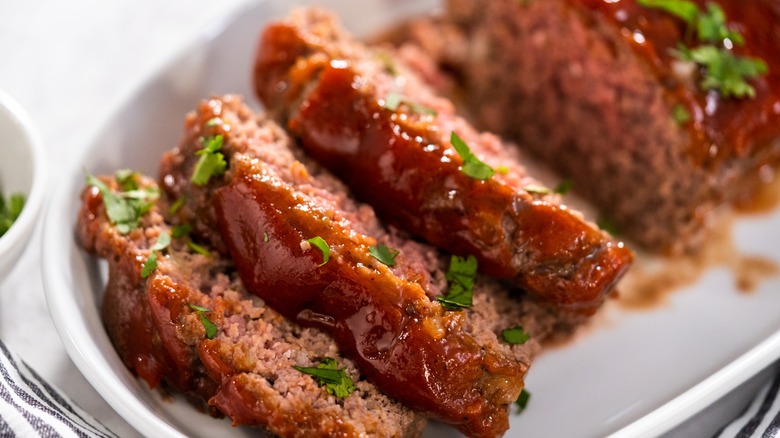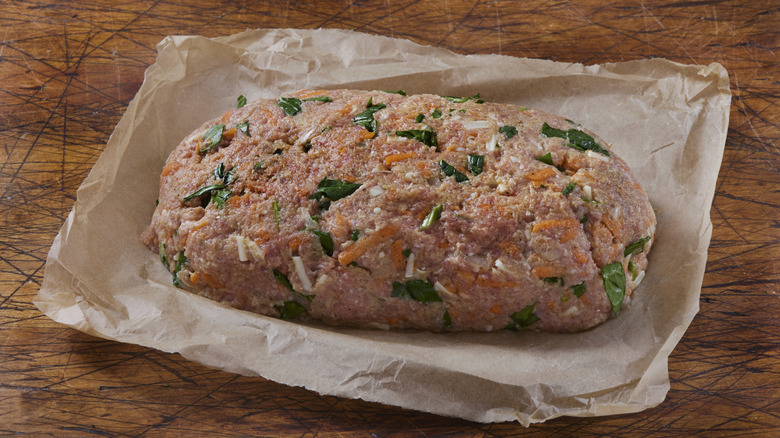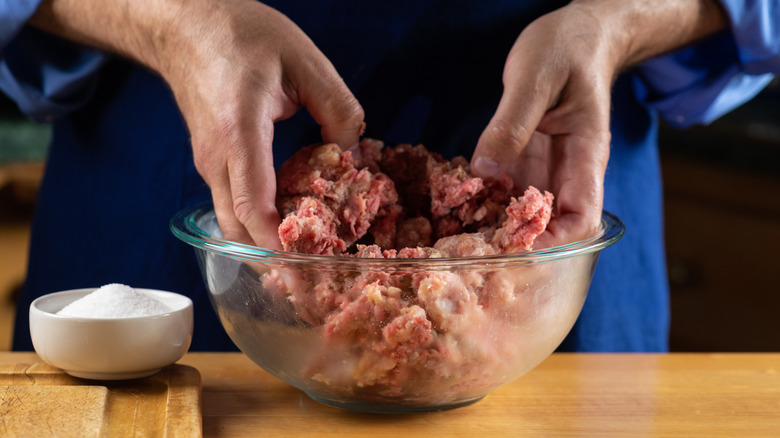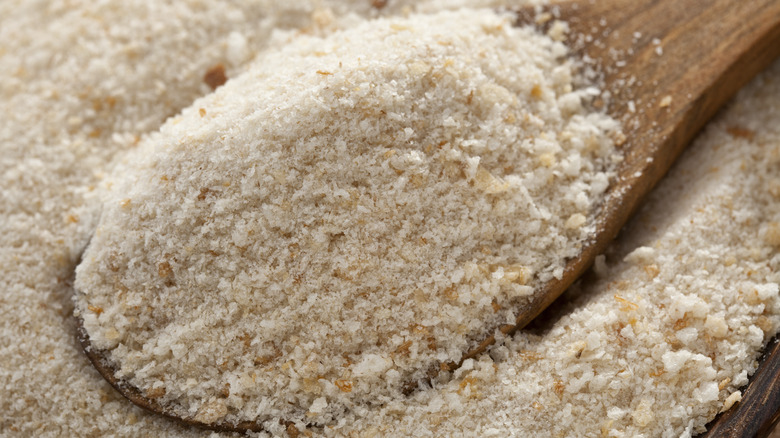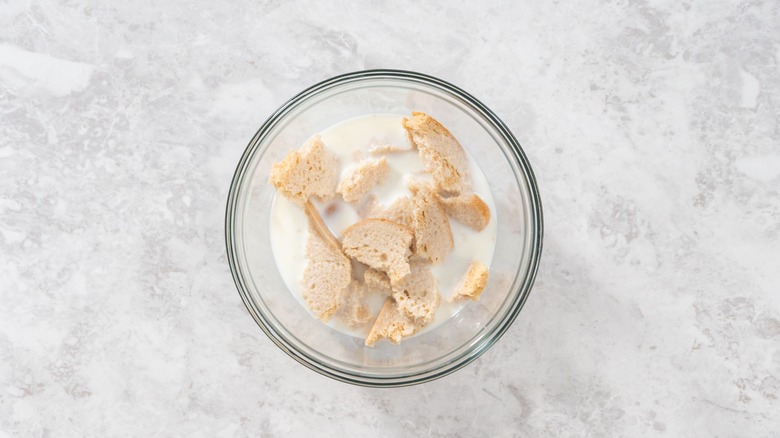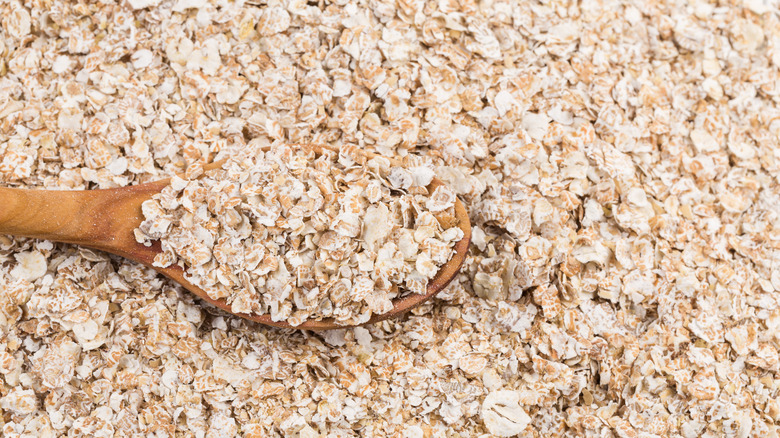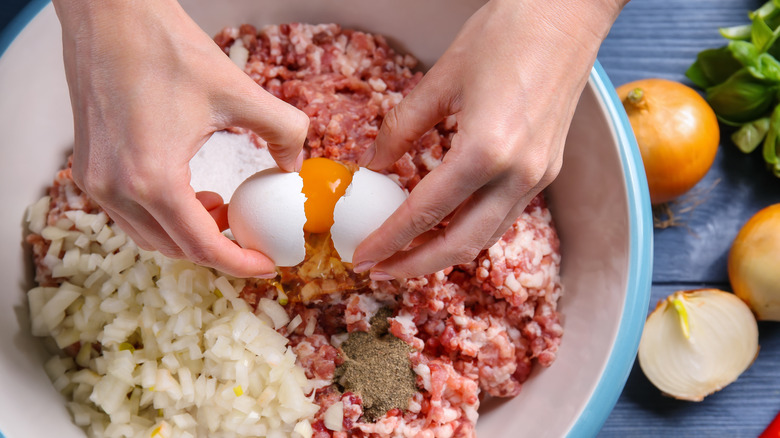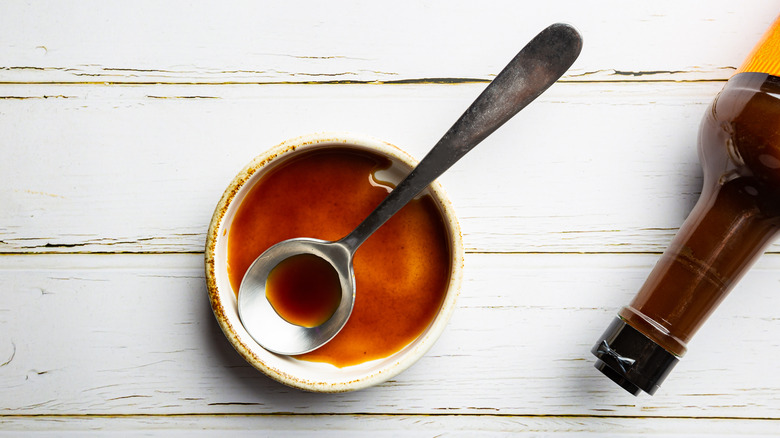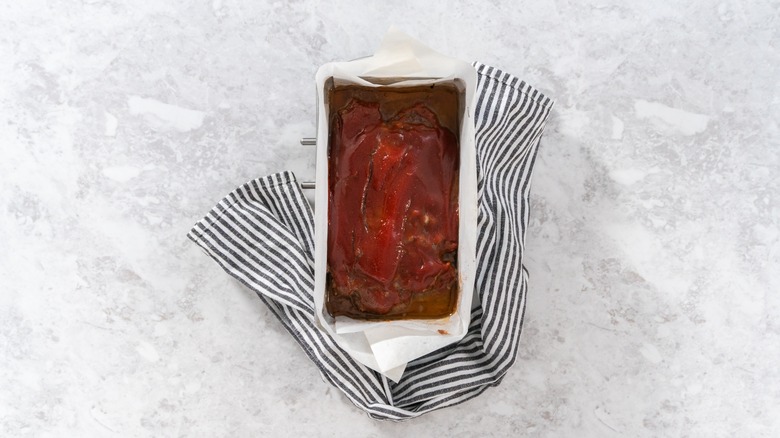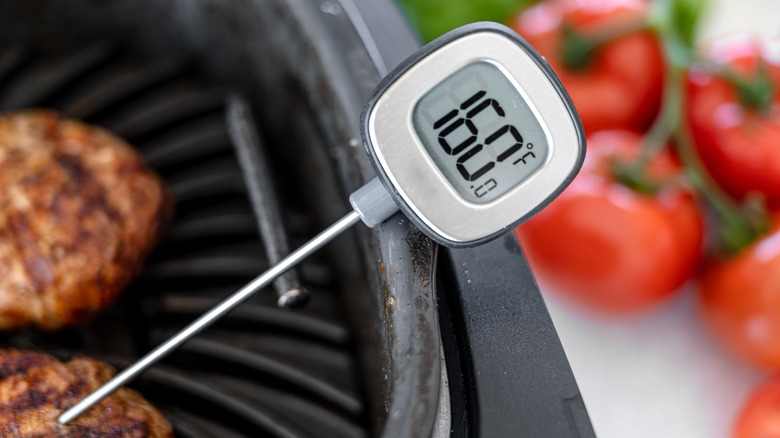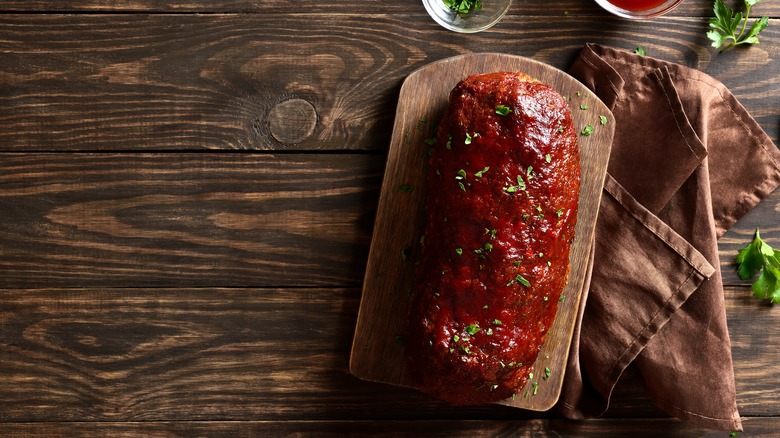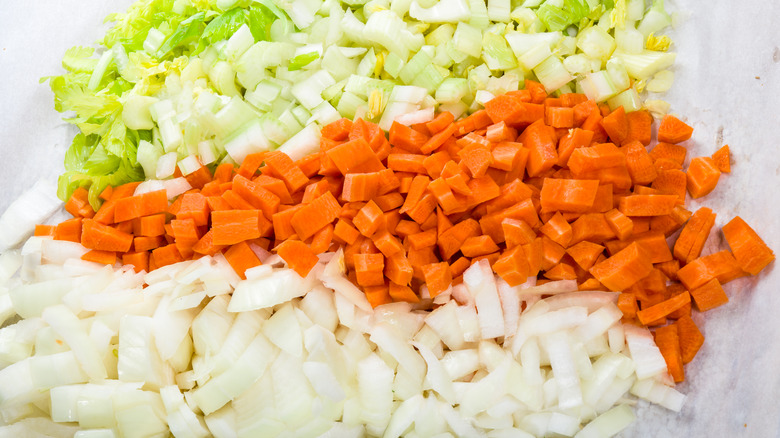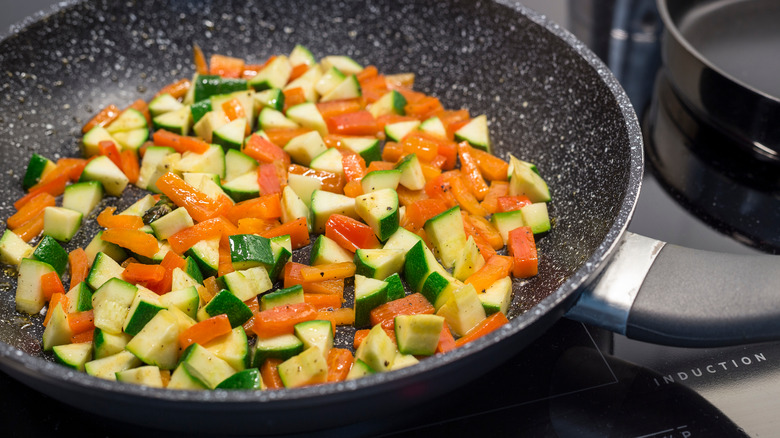12 Mistakes That Are Drying Out Your Meatloaf
Meatloaf is totally underrated — but this meal can be super satisfying (even addicting) when done right. If you aren't a fan of meatloaf, however, we really can't blame you. You probably had some dry meatloaf for a school lunch and were turned off of the stuff. What you don't know is there's a huge difference between a properly executed, moist meatloaf and a dry loaf. The former being a delicious and filling dinner recipe, and the latter, well, basically inedible. Achieving a perfectly moist and flavorful meatloaf isn't that straightforward, though, which is why dry meatloaf is so common.
In fact, there are a bunch of things that can go wrong while prepping a loaf, from using imprecise ingredients to skipping essential steps. And by no means are these blunders obvious to the untrained eye — once you realize your meatloaf is dry, it's hard to pinpoint where it went downhill. So to be sure your dish comes out perfectly juicy every time, your best bet is to understand what all the possible mistakes are. We'll guide you through these missteps, plus give you essential tips and secrets to master a delectable, juicy home-cooked meatloaf.
Using lean meat
The key to a moist meatloaf is using meat with a relatively high fat content. The fat acts as a natural basting agent, adding moisture and flavor to the meatloaf from the inside out. It also helps all the meat stick together and form the loaf structure. To achieve a perfect and juicy meatloaf, look for ground meats that have at least 15 percent fat. An ideal choice, ground chuck has about 20 percent fat and will create a meatloaf that's super moist but still firm enough to hold its shape.
Using lean meats, like turkey or ground sirloin, can actually make a meatloaf dry and grainy. This can be disappointing for those looking for a healthier meatloaf. But luckily there are workarounds. One trick is to add 1 to 2 tablespoons of olive oil into your meat mix before cooking to provide that very important fat content. Another option is to mix your proteins — combining lean meats with fattier meats like pork, lamb or veal in a 50/50 blend can make your loaf juicier and more flavorful. You can also add some minced bacon to your lean meat mix to increase fat content. And while this certainly won't make the dish healthier, it'll definitely amp up the flavor.
Overmixing meatloaf ingredients
Another common misstep when making a meatloaf is mixing your ingredients too much. In general, mixing is super important for creating the perfect loaf: It distributes flavor and primes the meat for sticking together. But when you mix too much, it can be bad news for your meatloaf. Not only does it cause dryness, but it can also mess with the texture. Too much mixing can cause the protein strands in the meat to cling together tightly, ultimately creating a rubbery and dense meatloaf.
The key is to stop mixing right when your ingredients are just incorporated. That means your best bet is to use your hands or a fork over an electric mixer or food processor. Combining everything manually will give you way more control over how much you mix. Another tip is to combine your ingredients first before adding them to your meat. This will help prevent overmixing while trying to distribute everything together evenly.
Using too much or too little filler
Filler like breadcrumbs or stale bread play an important role in the meatloaf recipe. It soaks up all the juices from the meat and keeps them locked inside the loaf so it's nice and moist when done cooking. Without filler, the fat from the meat would drain out. Breadcrumbs and other fillers also add a deliciously tender texture to the meatloaf that make it less hamburger-like. Achieving the right balance is important, though, since too much can also make your meatloaf dry.
A rule of thumb to follow is making sure your meatloaf mix is in the range of 15 to 25 percent breadcrumbs or other filler. So, practically speaking, if you're making a meatloaf with 2 pounds of ground beef, you should aim to use about ¾ cups to 1 cup of breadcrumbs. Panko is a classic choice for meatloaf, but there are a ton of different fillers you can use, like crackers, stale bread and even oatmeal.
Not soaking your bread
Using stale bread as a filler in your meatloaf can make it extra moist, but only when it's prepared properly. If your meatloaf recipe calls for bread, you'll definitely want to soak it in a liquid first. Neglecting to soak your bread while prepping a meatloaf will almost always lead to a dry, crumbly loaf. When not properly hydrated, bread will suck up too much of the meat's juices without contributing anything of its own. Soaking bread in liquid like milk, dairy-free milk or broth will ensure the loaf stays moist throughout the cooking process by retaining the meat's juices while also acting as a basting agent to keep the loaf moisturized.
For this step, break up your stale bread into pieces and put in your solution, making sure they're soaked. This should take five to 10 minutes. Remove the breadcrumbs and combine with your other ingredients before adding the meat.
Skipping oatmeal as a starch
You've heard of breadcrumbs and stale bread as a filler, but did you know oatmeal can also be used? In fact, oatmeal can actually hold moisture better than plain breadcrumbs and will help keep the loaf perfectly shaped. It's also a healthier option when it comes to fillers. Compared to stale bread or breadcrumbs, oatmeal has way more fiber, which will help keep you feeling fuller for longer. And since oats are gluten-free, this is the filler you'll want to use if you have a gluten allergy or intolerance.
The best type of oatmeal to use in meatloaf are quick-cooking rolled oats. Less processed oats like steel cut oats require longer cooking time and might not be done by the time your meatloaf is ready. Plus, quick-cooking oats are smaller than regular oats and will result in a less-grainy texture. To use oatmeal in a meatloaf recipe, add about 1 cup of oatmeal for 2 pounds of ground beef.
Not using eggs
Besides a starch, meatloaf requires a binder ingredient that will keep the meat from falling apart. This is especially important if you're cooking a free-form meatloaf, which is when you form the meatloaf with your hands instead of using a pan. The humble egg makes for the perfect binder when it comes to meatloaf, and is used in almost every basic meatloaf recipe. That's because it does two jobs really well: It binds the meat together and keeps the meatloaf moist. Thanks to the fat and proteins in the egg yolk, using eggs in meatloaf is key to a juicy loaf. Plus, it'll give your dish a super rich flavor.
When using eggs in a meatloaf recipe, the golden ratio is one or two large eggs per pound of meat. Mix your eggs gently before adding to the rest of the ingredients so the yolk and whites can be evenly distributed.
Not adding sauce to your meat mixture
Sauce doesn't just go on the meatloaf or on the side. If you're not putting sauce in the meat mixture before cooking, your meatloaf isn't living up to its juiciness potential. There are a ton of options when it comes to the type of sauce you can use — ketchup, barbecue sauce, Worcestershire, soy sauce and even fish sauce each add a unique flavor to the final dish.
Ketchup is typically the most commonly used, and with good reason. It adds a sweet component to the savory meatloaf dish which helps balance the flavors really well. It's also super viscous so it won't evaporate during cooking. Though what you use as a sauce in your meatloaf mix is totally up to your preference as they all achieve a similar goal ... creating a moist and flavorful meatloaf. Just be careful when using a salty addition like soy sauce that you're not adding too much.
Omitting a glaze
A glaze is like the cherry on top of a perfect meatloaf. It helps seal in the moisture while adding a delicious layer of sticky goodness to the dish. Popular glazes include ketchup, barbecue sauce or a brown sugar glaze. Ketchup adds a hint of sweetness that complements the savory meatloaf, while barbecue sauce is more on the smoky side. Brown sugar glaze is perfect for those who like the taste of caramelized flavor.
To add a glaze to your meatloaf, cook your loaf normally until it's just about done. Then, brush the top of your meatloaf with the glaze until it's completely covered. Stick your loaf back into the oven, and keep an eye on it while it cooks. Be sure to skip the tin foil as a cover once the glaze is applied — this will ensure the top gets as crispy as possible for extra texture. Once the glaze starts to caramelize, your meatloaf will be ready to serve.
Cooking at high temperatures or for too long (or both)
Overcooking a meatloaf is a surefire way to dry it out. That's why it's important to get the cooking time and temperature right. It can be tricky, since cooking times vary based on the size and shape of your loaf, and the true temperature of your oven. An internal thermometer can be super useful in this case since it'll tell you when your meatloaf is safe to eat. Once your loaf reaches 160 degrees F, it'll be good to go. Otherwise, too low of an internal temperature can be dangerous since it won't kill off potential food borne illnesses.
When cooking meatloaf, it's best to go low and slow. A general practice is a cooking temperature of 350 degrees F for 35 to 45 minutes per pound. So if you're cooking 2 pounds of meatloaf, it should take 70 to 90 minutes. Take the temperature of your meatloaf when it's almost finished cooking in case it gets done early.
Not letting the loaf sit after baking
It's tempting to serve the meatloaf right when it comes out of the oven, especially when you've been dreaming about it all day. But the reality is that it's actually better to wait a bit. Slicing into the meatloaf prematurely will result in a loss of all that moisture you worked so hard to create and preserve. By letting the loaf sit for a while once it's done cooking, it allows the juices from the meat to settle and distribute evenly so they all won't come pouring out once you cut into the loaf. Plus, the meat will hold together better so you'll have a cleaner slice. And if that hasn't convinced you, after the meatloaf has rested for a bit, it also gives the flavors a chance to meld and intensify, which will transform it into an even tastier loaf.
The ideal rest time is about 15 minutes. While it sits, we recommend covering it in foil to keep any more moisture from escaping out in the form of steam.
Skipping the vegetables
Despite meatloaf being a meat-forward dish, there are a ton of benefits of adding vegetables to the mix. Besides making your meatloaf healthier, another huge plus is that it adds more moisture to your loaf while it cooks. Carrots, celery and onions are a classic blend (aka Mirepoix) to include in your meatloaf. The combination of veggies adds complementary flavors to the savory loaf while breaking up the monotony of the meat with some textural variety.
There are other vegetables that make great additions to meatloaf besides the three listed. Consider including mushrooms, which can add a hint of umami flavor to the dish. Green and red bell peppers are another tasty addition by contrasting the savory meat flavors with a touch of brightness. Carrots, zucchinis, spinach, garlic and tomatoes are also fair game. The key is to finely dice or puree your veggies to prevent a chunky texture in your meatloaf. It will also make the veggies basically unrecognizable, which is a plus if you — or your kids — aren't a huge fan of them.
Using raw vegetables in your loaf
The biggest mistake when adding vegetables to your loaf is using raw veggies. Cooked veggies will impart way more flavor and, most importantly, lots of moisture, into your meatloaf than uncooked vegetables will. And since meatloaf needs to be cooked at a low 350 degrees F, it's not nearly hot enough to completely cook the raw vegetable bits thoroughly anyway. That means you'll end up with crunchy nuggets of uncooked vegetables in your loaf.
While the extra step of cooking your vegetables isn't ideal, it's definitely worth it. Simply sauté the veggies together in a pan with some olive oil or melted butter until they soften. A few minutes should do, though carrots might take longer. When the veggies are done, let them cool then mix with the rest of the meatloaf ingredients. If adding onions or bell pepper to your meatloaf, grill and char these veggies, because that smokey boost in flavor will wow you.

